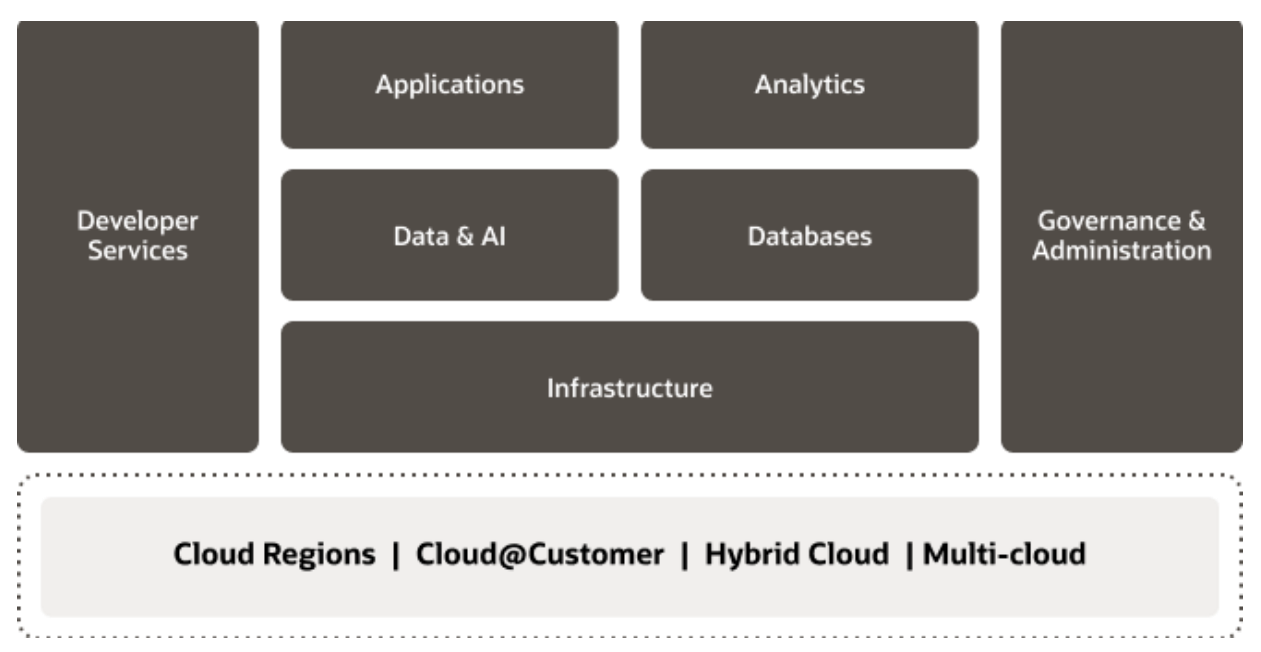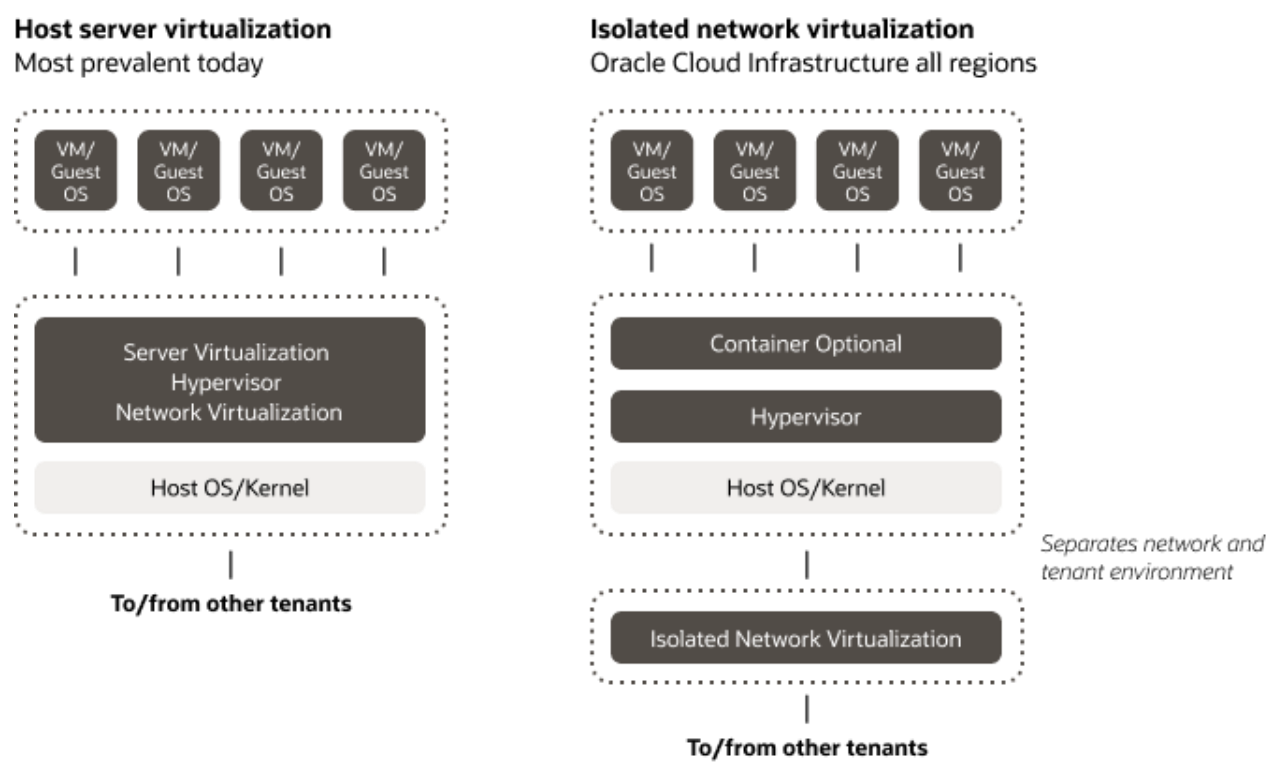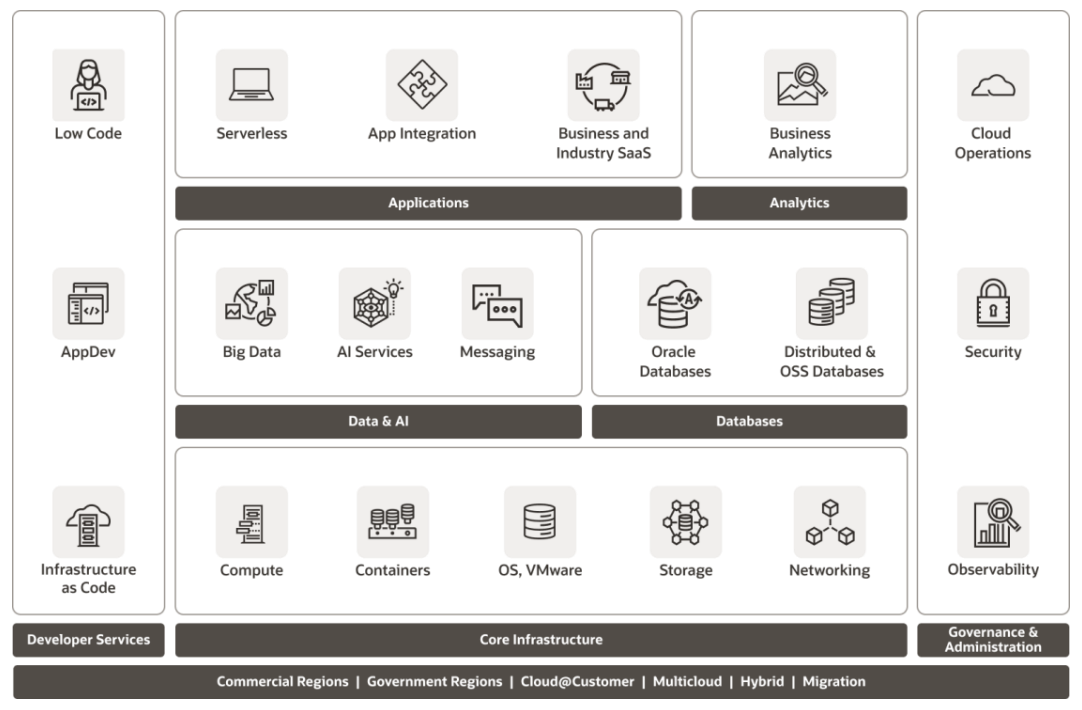Oracle Cloud Infrastructure (OCI)
Oracle Cloud Infrastructure launched in October 2016 with a single region and core services across compute, storage, and networking. Since then, Oracle Cloud has expanded to more than 70 services available in 29 cloud regions worldwide with plans to reach 38 total regions by the end of 2021. OCI offers relational, OLAP, JSON, and NoSQL databases, containers, Kubernetes, serverless functions, Spark, streaming, Jupyter notebooks, VMware–the range of cloud services necessary for nearly any workload. In 2020 alone, Oracle Cloud Infrastructure launched nearly 400 new services, features, and enhancements.
While other clouds were originally designed to support web and "scale out" cloud native applications, we saw an opportunity to build our cloud differently. Most companies have three additional classes of applications: enterprise applications that use relational databases, technical applications, and departmental applications. The first two have typically required modifications or even rewrites to run in the cloud, while the third has often been replaced by SaaS alternatives. Oracle has invested deeply to build core infrastructure services from the ground up to make it easy for customers to run all five classes of applications. Atop Oracle Cloud Infrastructure, Oracle also offers a broad and deep array of cloud applications (SaaS) for nearly any departmental and industry-specific need.

Figure 1: Oracle Cloud services
To address all five major classes of applications in a single cloud, we made design choices and innovated at every layer. We built our cloud regions with greater resiliency down to the individual node to make it easier to run enterprise applications with high availability (HA). We minimized hops and protocol translations in the physical network to achieve sub-millisecond latency within availability domains. At the virtual networking layer, we don't oversubscribe, so every resource gets maximum bandwidth without contention from other tenants. We're the first cloud provider to implement Layer 2 network virtualization, which enables customers to natively run VMware underneath enterprise applications in our cloud, and supports other key requirements like clustered databases for HA.
Oracle Cloud Infrastructure was also the first major cloud provider to implement “off-box” or isolated network virtualization, which takes network and IO virtualization out of the server stack and compute hypervisor and puts it in the network. As a result, customers can provision self-service, dedicated hosts with no hypervisor overhead, noisy neighbors, or shared resources with a full software-defined Layer 3 network topology. Virtual Machines (VMs) also benefit from this technology with reduced hypervisor overhead and improved isolation. All Oracle Cloud services that use compute also benefit with consistent high performance–everything from our Container Engine to our MySQL service.

Figure 2: Oracle Cloud Infrastructure Off-Box Network Virtualization
Off-box network virtualization enables running bare-metal instances side-by-side with any class of systems–from VMs to containers to optimized database systems like Oracle Exadata–all using the same set of APIs. With Oracle Cloud, customers can leverage unique Exadata capabilities (tens of millions of IOPS, IO prioritization, columnar compression) to run Oracle Databases, together with the cloud-native security and governance capabilities of a Layer 3 virtual cloud network.
Oracle Cloud Infrastructure core products overview
Oracle Cloud Infrastructure offers over 70 cloud services, so we will cover only the high-level domains.

Figure 3: Oracle Cloud Infrastructure service domains
Compute and containers
Oracle Cloud Infrastructure Compute lets you provision and manage single-tenant servers (dedicated bare-metal
servers), multi-tenant VMs, or dedicated-host VMs using the same set of APIs. You can spin-up truly elastic, selfservice, pay-by-the-hour bare-metal servers in a few minutes or flexible VMs, where you can select exactly the amount of OCPUs (i.e. cores) and memory you need, in seconds. Oracle offers Intel and AMD X86 CPUs, Ampere Arm CPUs, and Nvidia GPUs. Oracle Cloud Infrastructure Container Engine for Kubernetes is a fully-managed, scalable, and highly available service to deploy containerized applications in the cloud. Use Container Engine when your development team wants to reliably build, deploy, and manage cloud-native applications. You specify the compute resources that your applications require, and the Container Engine provisions them on Oracle Cloud Infrastructure in an existing OCI tenancy.
Networking and connectivity
Oracle Cloud Infrastructure Networking lets you create and manage a software-defined network we call a Virtual Cloud Network (VCN). A VCN is a virtual version of a traditional on-premises network, where customers can choose their own RFC 1918 IP addresses and define subnets, route tables, gateways and firewall rules to support routing of public and private traffic. Oracle Cloud Infrastructure Load Balancing allows you to create a highly available load balancer within your VCN so that you can distribute requests from the Internet, or within the VCN. OCI Load Balancing also offers flexible capabilities to scale up and down on-demand. Oracle Cloud Infrastructure FastConnect provides 1 or 10 Gbps private line connections between your facilities and the Oracle Cloud through over 50 global network providers. Oracle also offers the unique ability to directly connect to Microsoft Azure in seven global locations with ~2
millisecond latency and federated identity, addressing a number of multi-cloud use cases.
Storage
Oracle Cloud Infrastructure Block Volumes provides high-performance network storage that supports a broad range of I/O intensive workloads. You can use block volumes to expand the storage capacity of your compute instances or to provide durable and persistent data storage that can be used with different compute instances and even across multiple compute instances (multi-attach). You can flexibly adjust Block Volume performance, as well as increase capacity, online. Oracle Cloud Infrastructure Object Storage provides high throughput storage with near infinite capacity for unstructured data like logs, images, and videos. Applications like Spark can use Object Storage for large scale persistence.
Databases
Oracle Autonomous Database offers fully automated databases optimized for transaction processing, data warehousing, or document-oriented workloads (JSON). These databases provide higher security and optimal experience by self-patching, self-tuning, and auto-scaling, without downtime. Oracle Autonomous Database is built on top of Oracle Exadata and offers shared or dedicated deployment options. The dedicated option isolates the underlying infrastructure resources to a single tenant. Oracle Cloud Infrastructure Database and Exadata Cloud let you easily build, scale, and secure Oracle databases with license-included or Bring Your Own License (BYOL) pricing. You create databases on VMs, bare-metal instances, or Exadata instances. With OCI Database services, you can then use your existing tools, RMAN, and the database CLI to manage your databases in the cloud the same way you manage them on-premises. Oracle also offers managed MySQL and NoSQL databases.
Data platform, data science, and analytics
Oracle Cloud Infrastructure Data Integration, Oracle Cloud Infrastructure Streaming, and a range of other tools enable ingest of nearly any data format from on-prem and cloud sources. Oracle Cloud Infrastructure Data Catalog enables customers to keep track of their data across multiple OCI data stores. Data scientists have a familiar range of Python based tools to build, train, and manage machine learning models with Oracle Cloud Infrastructure Data Science. Business and IT analysts can use Oracle Analytics Cloud, a managed service for self-service analytics of data within your OCI environment, as well as external data sources.
Applications and integration
Oracle Integration Cloud offers broad application integration capabilities across Oracle and third-party SaaS, on-prem applications, and industry standards like FTP. Beyond cloud infrastructure, Oracle also offers a large range of business software as a service applications including Enterprise Resource Planning, Customer Experience, Human Capital Management, Supply Chain Management, and more. Available in the same global cloud regions, Oracle also offers a wide range of industry specific solutions for banking, risk management, clinical trial support, billing, and much more.
Security and governance
Identity and Access Management (IAM) service lets you control what type of access a group of users have and to which specific resources. Oracle simplifies governance with capabilities such as compartments (logical isolation of resources for usage and billing) and policies with a SQL-like syntax that is easier to create and manage. Oracle Cloud Infrastructure Vault service provides centralized management of data encryption and secrets. You can use Key Management to create or import master encryption keys, generate data encryption keys, rotate keys, enable or disable keys for use in cryptographic operations, assign keys to resources, and use keys for encryption and decryption. Oracle Cloud Infrastructure Audit provides visibility into activities related to your resources and tenancy. Audit log events can be used for security audits, to track usage of and changes to Oracle Cloud Infrastructure resources, and to help ensure compliance with standards or regulations. Oracle Cloud Observability and Management Platform provides a comprehensive set of management, diagnostic, and analytics services that enables easy diagnostics of cloud-native and traditional technologies deployed in the cloud or on-premises. The platform adopts an open, standards-based approach that is vendor-agnostic, supporting ecosystem interoperability out-ofthe-box with Slack, Twilio, PagerDuty and others.
Developer services
Oracle DevOps services and tools automate the software development lifecycle (SDLC), infrastructure operations, observability, and messaging for developers. Customers can use popular open-source tools such as Jenkins, Terraform, Grafana, and Spinnaker to integrate with Oracle Cloud Infrastructure. You can access Oracle Cloud Infrastructure through an intuitive graphical user interface, REST APIs, SDKs or a command-line interface (CLI). OCI also offers a browser-based terminal called Cloud Shell.
Explore More

